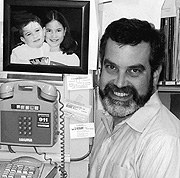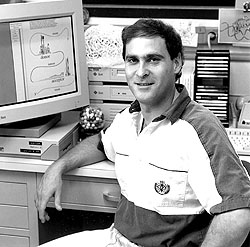
| T H E N I H C A T A L Y S T | M A Y – J U N E 1999 |
|
|
|
| P E O P L E |
RECENTLY TENURED
 |
|
Amy
Hauck Newman
|
Amy Hauck Newman received her Ph.D. in medicinal chemistry from the Medical College of Virginia in Richmond in 1985 and postdoctoral training in the Laboratory of Medicinal Chemistry, NIDDK. She was a research chemist at Walter Reed Army Institute of Research from 1988 to 1990, when she became a senior staff fellow at NIDA, where she initiated a medicinal chemistry research program in the Psychobiology Section. She is now a senior investigator and chief of the Medicinal Chemistry Section at NIDA.
My research interests are in the design and synthesis of highly selective ligands for the characterization of the protein targets of psychomotor stimulants and the development of medications to treat stimulant abuse.
It is well known that cocaine binds to dopamine, serotonin, and norepinephrine transporters and thereby inhibits reuptake of their respective neurotransmitters.
The mechanism(s) underlying the reinforcing, or addictive, effects of cocaine, however, appears to primarily involve the inhibition of dopamine uptake. Thus, we directed our efforts toward designing novel ligands with high affinity and selectivity for the dopamine transporter.
Our initial synthetic studies were based on structural modification of a known dopamine-uptake inhibitor and treatment for Parkinson’s disease, benztropine. This molecule shares several structural features with both cocaine and another known dopamine-uptake inhibitor, GBR 12909, but does not show reinforcing effects in animal models of drug abuse.
By developing novel compounds with benztropine as the parent ligand, we could make structural and pharmacological comparisons with cocaine and learn more about drug-transporter interactions and how these translate into the behavioral effects of these drugs.
Through these studies, we discovered a novel series of ligands that binds with high affinity to the dopamine transporter and inhibits dopamine uptake. However, in comparison with cocaine, this series of compounds is selective for the dopamine transporter and is distinct in chemical structure, structure-activity relationships, and behavioral profile. Specifically, animals treated with these dopamine-uptake inhibitors do not demonstrate cocaine-like behavior typical of psychostimulant abuse, and some of the compounds attenuate cocaine-induced behaviors. Based on these findings, we hypothesized that these benztropine-based ligands interact at a binding domain on the dopamine transporter that is different from that of cocaine and may thus lead to behaviors unlike those associated with cocaineuse.
We recently synthesized a novel photoaffinity label that we used in immunologic and proteolytic mapping to demonstrate that, in fact, this ligand labels a binding domain in the 1-2 transmembrane region of the dopamine transporter, rather than the 4-7 transmembrane region labeled by a cocaine-based photoaffinity ligand. We are currently designing cysteine residue—specific irreversible ligands that will allow the structural elucidation of the binding domain of these dopamine uptake inhibitors and will relate them to function of this protein.
We are also studying other structurally diverse classes of compounds to further characterize the dopamine transporter and other systems that may be related to cocaine abuse, such as the dopamine D3 receptor subtype. We are developing both two- and three-dimensional quantitative structure-activity relationship models as an approach that complements classical rational drug design and that will allow us to identify new lead compounds for future chemical modification.
We hope that by elucidating mechanisms underlying the reinforcing effects of cocaine, through the use of precise molecular probes, we may ultimately be able to design therapeutics for the treatment of cocaine abuse.
 |
|
Marc
Reitman
|
Marc Reitman received his M.D. and Ph.D. degrees from Washington University in St. Louis in 1983. He then did a residency in internal medicine at New York’s Columbia-Presbyterian Hospital before coming to NIH in 1986 as a clinical fellow in the NIDDK Laboratory of Molecular Biology. He is now a senior investigator in the Diabetes Branch, NIDDK.
I am interested in the molecular mechanisms regulating body weight and metabolic efficiency. Obesity is a major medical problem that particularly increases the risk of diabetes, lipid abnormalities, and hypertension. Genetic background contributes greatly to an individual’s chances of being obese.
In spite of the magnitude of this problem, surprisingly little is understood about the genes and molecular mechanisms underlying obesity and how obesity predisposes to diabetes. My laboratory focuses on developing and characterizing mouse models to understand the genetic contributions to obesity and diabetes.
The discovery of leptin in 1994 inspired my study of energy homeostasis. Since obesity and diabetes are properties of the whole animal, it became clear that we would also need to study whole animal physiology.
We concentrate on the mouse to take advantage of knockout and transgenic mutants, and we have developed the ability to measure metabolic rate and to continuously monitor body temperature.
Three projects are ongoing in the laboratory: regulation of leptin expression, characterization of uncoupling protein-3, and analysis of a transgenic mouse that is nearly devoid of white adipose tissue.
Leptin is a hormone secreted from adipose cells in proportion to fat mass, signaling stored energy levels to the rest of the body, particularly the hypothalamus. Leptin controls energy intake, metabolic efficiency, and energy expenditure. A low leptin level signals the body to conserve energy.
We are interested in how leptin expression is regulated. One step toward understanding this was our identification of promoter elements that mediate adipose-selective expression. Another key issue under investigation is how adipocyte fat content regulates leptin transcription.
We have also studied the biology of leptin in pregnancy, when circulating leptin levels increase. In humans, the 2-fold increase is due to placental transcription driven by a placenta-selective enhancer. In contrast, in mice, leptin rises 20-fold during gestation, but is not made in the placenta. Instead, the placenta makes a binding protein (soluble leptin receptor) that prevents leptin clearance. The roles of leptin during pregnancy are not clear, and they may even be different between species.
A fundamental observation central to research in this field is that the body "defends" or strives to maintain its weight by becoming more metabolically efficient after weight loss and less efficient upon weight gain. This is one of the reasons that dieting to lose weight is so difficult and frustrating. The molecular bases for these adaptations are unknown, but presumably include changing the flux through inefficient and/or futile metabolic cycles.
In 1997, we (and others independently) discovered uncoupling protein-3 (UCP3). This nuclear gene encodes a protein that is predicted to cause a mitochondrial proton leak. We have shown that UCP3 will reduce the mitochondrial membrane potential when expressed in yeast. UCP3 is expressed in muscle and is upregulated by thyroid hormone. Taken together, these data suggest that UCP3 has a role in the regulation of metabolic rate and efficiency. We have made and are currently characterizing a UCP3 knockout mouse to test these hypotheses.
In collaboration with Charles Vinson’s laboratory (NCI), we generated a transgenic mouse, named A-ZIP/F-1, that is virtually devoid of white fat. This was achieved using an adipocyte-specific promoter to drive expression of a dominant negative protein. The dominant negative protein inactivates certain basic-zipper transcription factors, preventing cell proliferation and differentiation. The A-ZIP/F-1 mice are diabetic, with a phenotype remarkably similar to that of humans with severe lipoatrophic diabetes.
Using transplantation to reverse the phenotype, we showed that it is the adipose tissue deficit that causes the diabetes. This is in stark contrast to the usual type 2 diabetes, which is associated with obesity. Thus the A-ZIP/F-1 mice are a model of a paradoxical, poorly understood form of diabetes and also allow the study of the physiologic roles of fat
 |
|
Thomas
Schneider
|
Thomas Schneider received his Ph.D. from the University of Colorado, Boulder, in 1984. He continued the same project, on molecular information theory, in both his postdoctoral work and at NIH in the Laboratory of Experimental and Computational Biology, NCI, where he is a senior investigator.
If you want to understand life, don’t think about vibrant, throbbing gels and oozes, think about information technology.
–Richard Dawkins, The Blind Watchmaker, 1986
I believe that living things are so beautiful that there must be a mathematics that describes them. In 1978, in the lab of Larry Gold in Boulder, Colorado, I started looking for mathematical ways to describe ribosome binding sites. I was working with frequency tables of the bases in the sites and gave a talk to some computer scientists. After the presentation, Andrzej Ehrenfeucht, the head of the group, suggested, "Why don’t you try the information transform?" I asked, "What’s that?" He wrote "p log p" on the blackboard. I asked, "What does that mean?" "Oh, you go look it up!"
Half a year later I got around to computing the information, and got 11.0 bits. But what did that mean? I soon realized that I could also compute how much information would be needed to find the binding sites, given the size of the genome and number of binding sites. I was stunned to get 10.6 bits. I was able to confirm for other genetic systems that the sequence conservation at binding sites (Rsequence, measured in bits) is close to the information needed to find them (Rfrequency, also in bits). That discovery launched my career.
At first, describing ribosomal processes in terms of information may seem simple. After all, it’s trivial to compute the expected frequency of EcoR I sites (5' GAATTC 3') as one in 4096 random bases. However, for ribosomes, the size of the genome and number of genes are fixed by physiology and history, but the patterns at the sites could be anything.
Indeed, I soon discovered that the region around bacteriophage T7 promoters has 35.4 bits, but only 16.5 bits are needed to find them. Either the budding theory—that binding site conservation evolves to match the minimum information needed to find the sites in the genome—was wrong or the data were telling us something new. I set out to do experimental work on these promoters. After four years of attempting to select for functional promoters, I found out that a functional T7 promoter will kill cells within three minutes of induction. To get around this problem, I used a toothpicking screen to isolate functional promoters from a chemically synthesized random library of T7 promoter variants. The variations destroyed the excess information, and I found that the polymerase only needs 18.2 bits to be strong enough to kill cells. Presumably the excess information represents the binding sites of another protein; we are hunting for it in the lab.
I found information theory extremely fruitful for describing binding sites in more than 50 genetic systems. At my web site, you will see two kinds of pretty graphics: sequence logos and sequence walkers. I invented sequence logos with my first Werner H. Kirsten Student Intern Program high school student, Mike Stephens. Using information to measure the sequence conservation at each position across a binding site, they represent an average picture of a collection of binding sites. They replace consensus sequences for making a picture of what sites look like and can show which face of the DNA a protein binds to. The area under a logo is Rsequence.
Logos give only an average picture. Can we assign an information content value to each individual binding site sequence so that their average is Rsequence? Marvelously, the mathematics "melts in your mind" to give a simple formula. My friend John Spouge (NCBI, NLM) then proved that this is the only possible formula that satisfies the averaging criterion.
My friend Pete Rogan (ABL, now at Children’s Mercy Hospital, Kansas City, Missouri) found a paper claiming that a certain T-to-C change at a splice junction in hMSH2 caused colon cancer. Pete looked at our splice acceptor logo and realized that nearly 50 percent of the time there are Cs there. The people working on hMSH2 had forgotten theoriginal data when they made their consensus sequence! Bert Vogelstein showed that 2 of 20 normal people have the change, so it is indeed a polymorphism. This case convinced us that information theory would be useful in predicting splicing effects in key disease genes.
To show how splice-junction changes affect the individual information content, I invented a computer graphic that "walks" across a sequence at one’s command. With these sequence walkers, complicated splice-junction mutations can be understood in seconds. One of my favorite cases is a low information content cryptic site lurking next to a strong normal site that is sitting on the end of an exon. A mutation of the sequence drops the information content of the site while simultaneously (!) raising the information content of the cryptic, which takes over. Since the cryptic site is out of frame, the protein is destroyed. We have analyzed more than 100 human splice-junction mutations using information theory. Jim Ellis (OD/ORS/BEPSP) has recently joined us. He is handling several international collaborations and is also set up on the main campus to do these analyses for scientists at NIH [see "Splice Junction Site"].
In 1983, I set out to understand how the information values I was measuring are related to the binding energy. The data were indicating a proportionality. What did that mean? Claude Shannon, who developed information theory 50 years ago, not only gave us a way to measure the amount of information, but also a way to determine how much information can be sent through a communications channel. This "channel capacity" is determined by the thermal noise and the energy dissipated. It can be used to find the maximum information that can be gained for a given energy dissipation. Surprisingly, I found that this is a new version of the Second Law of Thermodynamics. Using this, I was able to convert my proportionality to an efficiency of 70 percent. This means that 30 percent of the binding energy is "wasted" because it is dissipated but does not contribute to the choices being made. Why?
The mystery deepened when I stumbled on the fact that the quantum efficiency of rhodopsin is also 70 percent. That is, for every 100 photons that are absorbed and that excite a rhodopsin molecule, only in 70 cases does the rhodopsin change states. Later, at a lecture on muscle, I guessed that muscular efficiency would be the same, and was surprised to find that it is.
I went deeper into the theory and in 1989 found an elegant, purely geometric answer that explains why so many molecular machines are 70 percent efficient. I’ve been trying to finish the publications ever since then!
Where will this lead us? Information theory has proven itself in hundreds of genetic systems, and the door is now open for understanding any molecular interaction or state change using these well developed mathematical tools. In particular, I think the key to the future is coding theory. Fortunately, communications engineers have not been idle for the last 50 years. Telephone clarity, crisp CD music, and reliable Internet protocols are all based on the error-correcting codes predicted by Shannon. We are now in the same position in biology: There must be codes for molecular interactions; we only need to find them. Sequence logos and walkers appear to be a good start.
Knowledge of information
theory in biological systems can enlighten molecular design and provide a theoretical
grounding for nanotechnology. In my lab, the theory has led to our inventing
a practical molecular computer, which is patent pending. Three other patentable
nanotechnology projects are also in the works. ![]()